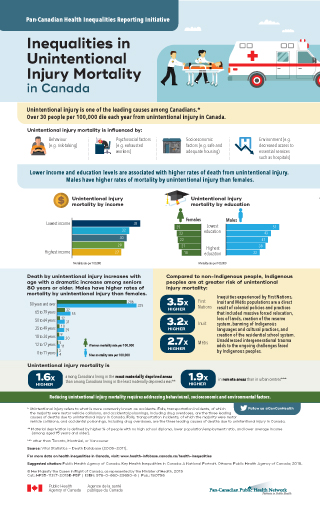Infographic: Inequalities in unintentional injury mortality in Canada

Download the alternative format
(PDF format, 1.59 MB, 1 page)
Organization: Public Health Agency of Canada
- Cat.: HP35-113/7-2019E-PDF
- ISBN: 978-0-660-29690-6
- Pub.: 180796
Pan-Canadian Health Inequalities Reporting Initiative
Inequalities in Unintentional Injury Mortality in Canada
Unintentional injury is the leading cause of death among Canadians.Footnote *
Over 30 people per 100 000 die each year from unintentional injury in Canada.
Unintentional injury mortality is influenced by:
- Behaviour (e.g. risk-taking)
- Psychosocial factors (e.g. exhausted workers)
- Socioeconomic factors (e.g. safe and adequate housing)
- Environment (e.g. decreased access to essential services such as hospitals)
Lower income and education levels are associated with higher rates of death from unintentional injury.
| By income | Mortality rate per 100 000 |
|---|---|
| Lowest income | 38 |
| 32 | |
| 30 | |
| 29 | |
| Highest income | 27 |
| By education | Mortality rate per 100 000 | |
|---|---|---|
| Men | Women | |
| Lowest education | 53 | 25 |
| 43 | 23 | |
| 41 | 22 | |
| 38 | 21 | |
| Highest education | 33 | 18 |
Death by unintentional injury increases with age with a dramatic increase among seniors 80 years or older. Men have higher rates of mortality by unintentional injury than women.
| Age group | Mortality rate per 100 000 | |
|---|---|---|
| Men | Women | |
| 0 to 11 years | 4 | 3 |
| 12 to 17 years | 11 | 5 |
| 18 to 34 years | 30 | 9 |
| 35 to 49 years | 29 | 10 |
| 50 to 64 years | 31 | 12 |
| 65 to 79 years | 55 | 32 |
| 80 years and over | 325 | 286 |
Compared to non-Indigenous people, Indigenous peoples are at greater risk of unintentional injury mortality:
- First Nations
- 3.5 times higher
- Inuit
- 3.2 times higher
- Métis
- 2.7 times higher
Inequities experienced by First Nations, Inuit and Métis populations are a direct result of colonial policies and practices that included massive forced relocation, loss of lands, creation of the reserve system, banning of Indigenous languages and cultural practices, and creation of the residential school system. Unaddressed intergenerational trauma adds to the ongoing challenges faced by Indigenous peoples.
Unintentional injury mortality is
- 1.6 times higher among Canadians living in the most materially deprived areas than among Canadians living in the least materially deprived areasFootnote **
- 1.9 times higher in remote areas than in urban centresFootnote ***
Reducing unintentional injury mortality requires addressing behavioural, socioeconomic and environmental factors.
Follow us @GovCanHealth
Source: Vital Statistics - Death Database (2009-2011)
For more data on health inequalities in Canada, visit:
www.health-infobase.canada.ca/health-inequalities
Suggested citation: Public Health Agency of Canada. Key Health Inequalities in Canada: A National Portrait. Ottawa: Public Health Agency of Canada; 2018.
© Her Majesty the Queen in Right of Canada, as represented by the Minister of Health, 2019 | Cat.: HP35-113/7-2019E-PDF | ISBN: 978-0-660-29690-6 | Pub.: 180796